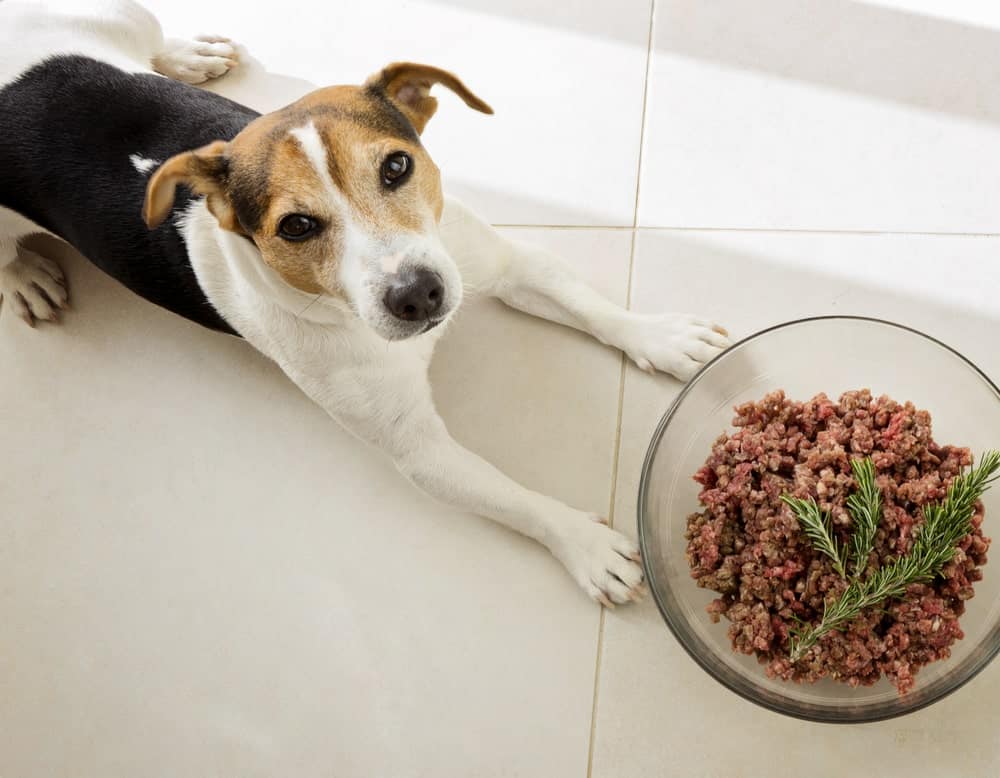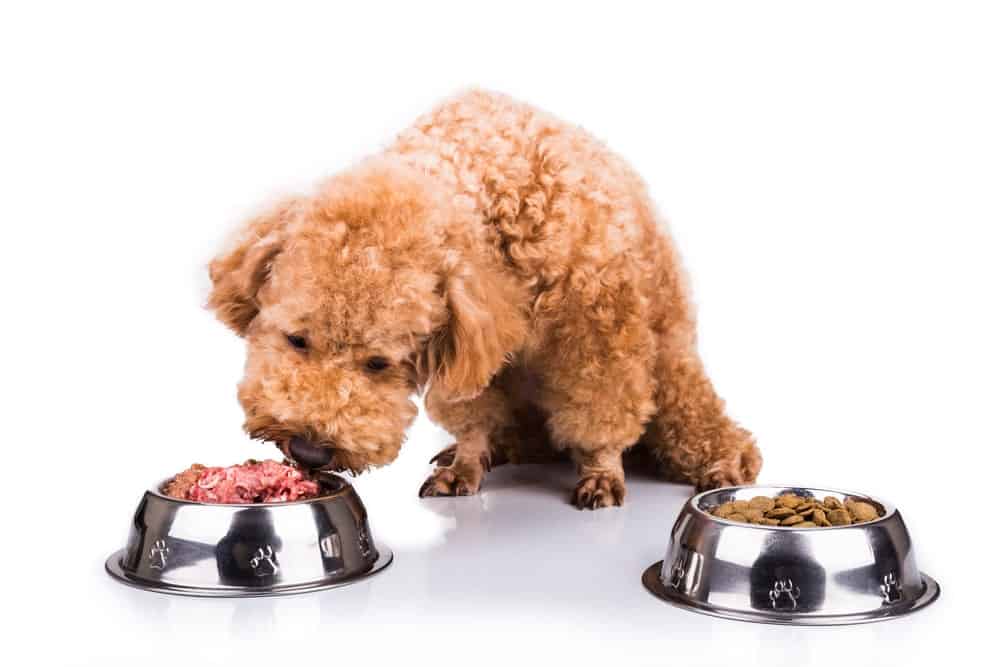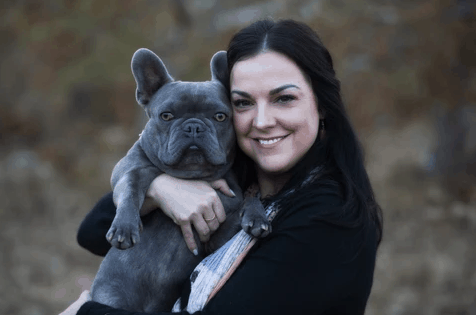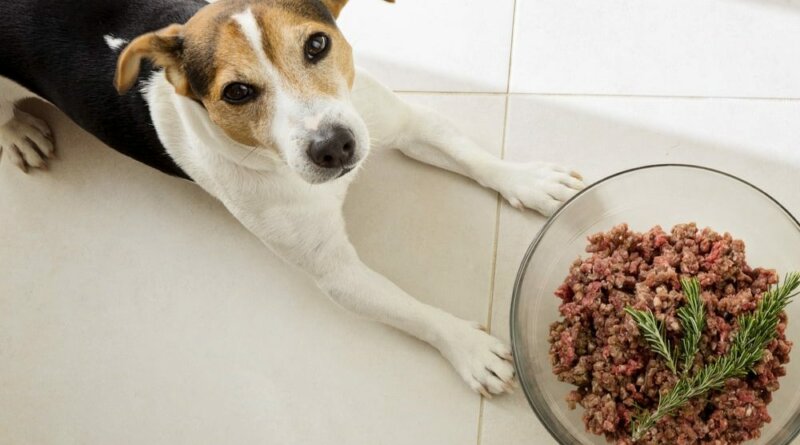Transitioning Your Dog to a Raw Food Diet
[ad_1]
By Brandine Strand
From a healthier coat, to improved digestive health, to fresher breath, the benefits of feeding a raw food diet to your dog abound.
But as with most of life’s transitions, the
process of changing your dog’s diet to a raw one can be tricky — especially if
you are transitioning to a raw food from dry, processed kibble.

When it comes to introducing your dog to raw
foods, there is no perfect way for all pets. The best approach may depend on
your dog’s age, former diet, digestive system sensitivity, and other factors.
Rather than going cold turkey, try mixing raw food with your dog’s kibble
gradually. We recommend switching from a processed diet to a raw food one
slowly — ideally over the course of 7 to 14 days.
We’ve outlined the basic steps to a complication-free transition process to raw dog food below. Depending on how quickly your dog adjusts, each step may take between three to five days.
• Step 1: Begin by feeding your dog a blend of 20 percent raw food and 80 percent kibble. Continue for three to five days and keep an eye on the condition of your dog’s stool.
• Step 2: If your dog’s stool is mostly firm, you can move on to the next step: 50 percent raw food, 50 percent kibble. Continue this step for three to five days, making sure to monitor your pet’s stool. If your dog is experiencing diarrhea, do not proceed to the next step until the diarrhea has ceased or you talk to your vet.
• Step 3: If your dog is ready to proceed to step three, you can try feeding her a mix of 80 percent raw and 20 percent kibble for another three to five days.
• Step 4: If all is well, you can move on to the final step and switch to a 100 percent raw food diet.

Throughout these steps, it is normal to see a
change in consistency in your pet’s stool — though you should talk to your vet
if your dog experiences diarrhea for more than a few days. Your pup may
experience temporary tummy aches and soft stool as her system gets used to
their new diet, in addition to changes in how frequently she goes to the
bathroom. At the end of the transition process, your dog should have smaller,
firmer stools due to the lack of fillers and foreign ingredients in her new
diet.
4 Tips to Keep in Mind
Raw food diets are what nature intended for our canines to eat, but it is possible to run into complications due to human error during the transition process. Here are 4 tips to make the switch to raw as smooth as possible for your pooch:
1. Start out with a single protein.
No matter how gradual the transition, the switch from dry, processed kibble to raw food will come as a slight surprise to your dog’s system. If your dog starts to feel uncomfortable after being introduced to raw foods, she may become hesitant to eat. Sticking to a single protein source — such as turkey or chicken — will give your dog’s body more time to get used to the adjustment. You can try introducing new meats into your dog’s daily meals after a month or two.
2. Serve meals on an empty stomach.
If you have an adult dog, try feeding her only once every 12 hours to give her time to build up appetite and detoxify her system. If your dog is allowed to become hungry, she will be more eager to chow down on her next raw food meal. Note that this method should only be used with older dogs — puppies less than 12 months old need to be fed two to four times per day.
3. Serve room temperature on a plate.
You can enhance the appeal of your pet’s new
food by serving meals at room temperature. Allow refrigerated raw foods to warm
up for 30 minutes before serving.
Similarly, you can encourage your dog to eat by helping her see what she is eating. Instead of serving raw food in a deep bowl, try dishing it onto a plate so she knows what she is getting.
4. Keep calm.
Your dog may try to win attention and/or treats by refusing to eat. Try to avoid reacting, as showing concern can signal to a dog that her bad behaviors are working. If you remain calm and hold your ground, your dog will realize you mean business and decide to eat her new food rather than get nothing at all. Remember — every dog is different, so there is no one-size-fits-all approach to transition your pet to a raw diet. Use these guidelines as a basis, but feel free to adjust the process as needed. Staying positive will encourage your dog to adopt the same attitude. And the end result — a happier, healthier dog — will ensure the transition process has been well worth your effort.

Brandine Strand is an avid life-long dog mom & entrepreneur, passionate about holistic health & natural medicine. In 2018, she founded Cali Raw Nutrition, a premium raw dog food company that ships human-grade, complete & balanced, life-stage specific meals straight to your door. Brandine is dedicated to making it easy for dog lovers to provide optimal nutrition for the enhanced health & longevity of their dogs.
[ad_2]
Source link





purchase lanoxin without prescription buy lanoxin 250mg buy generic molnunat
acetazolamide 250mg generic buy imuran pills order azathioprine for sale
order digoxin 250 mg for sale buy micardis 20mg online molnupiravir 200 mg ca
buy amoxil 250mg for sale oral stromectol ivermectin 18mg
buy coreg 6.25mg generic ditropan sale buy elavil
order priligy 90mg avanafil 200mg us purchase motilium
alendronate without prescription order alendronate 70mg purchase ibuprofen generic
order indocin generic buy tamsulosin for sale order cenforce 100mg generic
nortriptyline for sale online buy paxil 10mg pill buy paroxetine 10mg generic
buy doxycycline 200mg without prescription buy methylprednisolone 8 mg online methylprednisolone price
generic tadalafil 10mg tadalafil 10mg usa buy amoxicillin pills
requip for sale online buy calcitriol 0.25 mg buy labetalol 100 mg generic
tricor 160mg usa sildenafil 100mg cost order sildenafil for sale
esomeprazole without prescription generic lasix lasix 100mg price
tadalafil 5mg cost Samples of cialis viagra canada
buy minocycline 100mg capsules order neurontin order hytrin 1mg without prescription
cheap glycomet 500mg metformin 500mg tablet purchase nolvadex for sale
modafinil 200mg us purchase stromectol pills order promethazine 25mg for sale
clomid 50mg over the counter clomiphene 50mg pills buy generic prednisolone
buy generic prednisone buy accutane 20mg sale amoxicillin tablet
order accutane 10mg online prednisone 10mg us acillin canada
order fildena 100mg pregabalin usa order proscar
ivermectin 0.5 lotion india buy prednisone 10mg generic order prednisone 10mg generic
zofran 4mg ca buy zofran 4mg pills order bactrim without prescription
order absorica amoxil cost purchase zithromax online cheap
strongest over the counter antihistamine order albuterol 4mg without prescription brand augmentin 625mg
order prednisolone 40mg for sale purchase prednisolone pills lasix 40mg brand
buy modafinil generic purchase lopressor without prescription metoprolol pills
doxycycline cheap purchase vardenafil for sale buy acyclovir
avodart 0.5mg tablet purchase avodart pills buy xenical 120mg generic
inderal cheap buy propranolol online carvedilol 25mg over the counter
order imuran 50mg generic azathioprine brand purchase naproxen pill
ditropan pills purchase oxcarbazepine sale purchase trileptal online
buy cefdinir 300 mg order omnicef online cheap protonix brand
simvastatin 20mg tablet promethazine 25mg drug purchase sildalis generic
avlosulfon for sale dapsone 100 mg us atenolol where to buy
order uroxatral without prescription cheap alfuzosin order diltiazem 180mg pill
order generic sildenafil 50mg viagra 200mg buy tadalafil 20mg generic
buy ezetimibe 10mg generic buy zetia 10mg online methotrexate 5mg cost
brand phenergan best price cialis cialis daily
warfarin tablet buy generic metoclopramide 20mg order allopurinol 100mg sale
buy levaquin 250mg online cheap order generic bupropion bupropion 150mg us
buy zyrtec 5mg pill cetirizine 5mg for sale zoloft 100mg over the counter
how to get cenforce without a prescription purchase cenforce buy glucophage pills for sale
order lexapro generic buy fluoxetine 20mg pill naltrexone 50 mg ca
order lipitor 20mg online cost lipitor 10mg overnight viagra delivery
letrozole buy online sildenafil otc sildenafil 100mg usa
tadalafil 40mg oral cialis 40mg cheap cheap erectile dysfunction pill
amoxil uk order azithromycin 500mg sale order prednisolone 40mg for sale
accutane brand buy azithromycin generic cheap zithromax 500mg
order generic gabapentin buy furosemide 40mg pill purchase vibra-tabs without prescription
buy prednisolone 20mg pills prednisolone order order lasix 40mg sale
buy ventolin online buy synthroid cheap synthroid 100mcg cheap
clomiphene ca plaquenil 200mg sale buy hydroxychloroquine 400mg without prescription
purchase doxycycline generic augmentin drug cheap clavulanate
atenolol 100mg without prescription medrol 4 mg tablets letrozole ca
synthroid 100mcg over the counter synthroid 150mcg usa oral levitra 20mg
buy albendazole 400mg online order generic albendazole 400mg provera 10mg usa
oral glucophage 500mg cheap atorvastatin 80mg buy generic norvasc
order biltricide 600 mg online microzide cost cost periactin 4 mg
cheap lisinopril order zestril 10mg generic lopressor generic
order generic pregabalin 75mg oral loratadine 10mg order priligy 60mg without prescription
methotrexate 10mg generic buy methotrexate generic metoclopramide 10mg usa
xenical 60mg us order acyclovir generic purchase zyloprim pill
hyzaar sale order cozaar 50mg pill buy topamax 200mg
how to buy crestor crestor 20mg us motilium 10mg tablet
buy imitrex pills for sale purchase levaquin pill oral avodart
sumycin drug baclofen cost buy baclofen
toradol 10mg pills toradol pills buy inderal online cheap
clopidogrel 150mg generic order ketoconazole generic nizoral price
buy flomax 0.2mg generic aldactone 100mg generic order spironolactone online cheap
purchase cymbalta online duloxetine 20mg pill piracetam order
buy betnovate 20gm for sale order clomipramine for sale itraconazole 100 mg for sale
prometrium price buy generic tinidazole for sale cheap olanzapine 10mg
oral nateglinide order captopril without prescription atacand 8mg drug
buy bystolic 5mg online buy diovan 160mg online cheap clozaril 50mg ca
simvastatin 10mg for sale order valacyclovir 1000mg sildenafil over counter
carbamazepine for sale ciplox brand lincomycin ca
cialis for sale buy cialis once daily purchase viagra sale
buy duricef sale lamivudine oral propecia order online
diflucan over the counter buy diflucan 200mg for sale order generic ciprofloxacin 1000mg
estradiol 2mg usa lamotrigine 200mg canada order minipress 1mg for sale
buy metronidazole 200mg without prescription keflex for sale buy generic keflex 125mg
order mebendazole 100mg sale buy vermox generic tadalis 20mg oral
clindamycin us generic erythromycin 250mg sildenafil drug
order avana online generic avana brand diclofenac
oral amoxicillin 500mg amoxicillin order biaxin 500mg tablet
where can i buy bimatoprost purchase robaxin sale buy trazodone 50mg generic
buy generic catapres buy generic tiotropium how to get tiotropium without a prescription
buy suhagra 50mg sale sildenafil oral sildenafil price
minocin 50mg brand brand pioglitazone buy pioglitazone 15mg
leflunomide 10mg tablet buy leflunomide azulfidine brand
buy isotretinoin 10mg generic isotretinoin 20mg over the counter zithromax 500mg tablet
tadalafil 5mg pill purchase tadalafil online cialis 5mg pills
buy azipro 500mg pills order omnacortil 10mg online cheap neurontin 800mg uk
ivermectin 90 mg purchase prednisone generic buy deltasone 10mg sale
lasix 100mg ca albuterol 4mg for sale purchase ventolin without prescription
buy vardenafil 10mg generic plaquenil drug generic hydroxychloroquine 200mg
buy generic altace over the counter etoricoxib 120mg us buy etoricoxib paypal
buy levitra medication vardenafil 20mg sale order plaquenil 200mg for sale
generic asacol 400mg order asacol generic buy generic avapro 300mg
order benicar pills depakote 250mg over the counter depakote 500mg uk
temovate usa buy buspirone 5mg generic buy cordarone 200mg for sale
order diamox online order imdur sale imuran 25mg over the counter
coreg 25mg generic aralen oral buy aralen sale
digoxin 250 mg us buy cheap generic micardis molnunat 200 mg generic
oral naprosyn 500mg order omnicef 300 mg generic lansoprazole 15mg without prescription
order albuterol without prescription pantoprazole brand brand pyridium 200 mg
buy generic singulair for sale buy generic amantadine for sale order avlosulfon 100 mg without prescription
baricitinib for sale online atorvastatin 10mg sale order atorvastatin 40mg pill
nifedipine online buy aceon ca buy allegra online
norvasc 10mg canada lisinopril price brand prilosec
priligy 90mg uk buy xenical tablets order generic xenical 60mg
lopressor buy online order lopressor 50mg generic buy methylprednisolone 8mg
diltiazem cost oral diltiazem 180mg buy generic allopurinol 300mg
buy generic aristocort buy triamcinolone 10mg online cheap order claritin online cheap
sumycin pills buy cheap flexeril buy ozobax no prescription
ampicillin tablet metronidazole price order flagyl 400mg sale
buy toradol 10mg online cheap ketorolac pill order inderal 20mg
septra sale keflex online order order cleocin 150mg generic
purchase clopidogrel generic buy generic medex order coumadin 5mg generic
cost erythromycin buy generic erythromycin online purchase nolvadex for sale
cost metoclopramide 20mg cozaar us brand nexium
buy budesonide sale buy generic cefuroxime 250mg buy bimatoprost online cheap
topiramate 200mg price order imitrex 25mg generic order levofloxacin 250mg online
robaxin ca purchase sildenafil generic order suhagra 100mg without prescription
dutasteride tablet order zantac 150mg buy generic mobic for sale
aurogra 100mg ca purchase sildalis online estradiol 2mg pill
order celebrex pills buy generic flomax online zofran 4mg cheap
order spironolactone online cheap order valtrex online valtrex generic
buy generic lamictal buy lamotrigine 200mg order prazosin 1mg online
buy finasteride order viagra sale sildenafil australia
retin ca buy generic tretinoin over the counter buy generic avanafil for sale
female cialis pill goodrx cialis sildenafil 50mg price
tadacip 10mg us order generic tadacip buy indomethacin 50mg without prescription
cialis without a doctor prescription buy diflucan generic buy ed medication
lamisil price trimox 500mg pill amoxicillin price
buy sulfasalazine 500mg generic buy olmesartan 20mg online buy calan for sale
buy anastrozole generic arimidex 1 mg tablet order clonidine 0.1 mg online
order divalproex 250mg pill order divalproex 500mg buy isosorbide generic
buy imuran 25mg generic buy cheap imuran micardis 80mg cost
buy meclizine 25mg sale buy minocin 100mg online cheap purchase minomycin online
brand molnunat 200mg purchase movfor without prescription cefdinir 300mg usa
erectile dysfunction medicines viagra sildenafil 50mg sildenafil for sale
order prevacid 15mg generic buy lansoprazole 30mg online protonix 40mg tablet
ed pills that work quickly sildenafil 50mg pills for men order generic tadalafil 20mg
pyridium 200mg generic singulair online buy amantadine 100mg usa
buy generic avlosulfon online buy generic adalat 10mg buy aceon without a prescription
natural ed pills purchase cialis for sale cialis cost
order fexofenadine generic order glimepiride 4mg generic cost amaryl 1mg
order arcoxia 60mg online etoricoxib for sale azelastine generic
buy avapro pills temovate generic buspirone pills
order cordarone 100mg online dilantin where to buy buy phenytoin no prescription
purchase albenza for sale order medroxyprogesterone 10mg online medroxyprogesterone 5mg uk
where can i buy ditropan fosamax 35mg cost order fosamax 70mg online cheap
biltricide cost cyproheptadine for sale buy generic cyproheptadine 4mg
luvox 100mg pills order duloxetine 40mg sale duloxetine 40mg pills
furadantin 100mg pill furadantin drug nortriptyline 25mg us
order generic glucotrol cheap piracetam 800 mg betamethasone for sale online
order anacin 500mg for sale paracetamol 500 mg drug buy generic pepcid
clomipramine 25mg cost order sporanox 100mg online cheap purchase progesterone
buy tinidazole 300mg online cheap zyprexa price purchase bystolic generic
tacrolimus 1mg sale order prograf 1mg pills order requip 2mg without prescription
buy diovan without prescription valsartan without prescription purchase combivent generic
purchase calcitriol sale order calcitriol generic tricor oral
dexamethasone 0,5 mg us nateglinide where to buy starlix 120 mg pill
oxcarbazepine 600mg sale oxcarbazepine 600mg cheap urso 150mg tablet
order captopril 25 mg generic cheap captopril 25mg order tegretol 400mg pill
zyban 150mg uk generic zyrtec 5mg strattera 25mg us
ciplox where to buy order cefadroxil 500mg online cheap brand cefadroxil
seroquel order online escitalopram pill order lexapro pills
purchase lamivudine generic combivir online buy quinapril 10mg tablet
order prozac 40mg purchase prozac online buy letrozole 2.5 mg pill
buy frumil tablets order clindac a generic brand acivir
purchase zebeta online cheap indapamide 2.5mg drug terramycin 250mg pills
valcivir 1000mg brand valaciclovir pills ofloxacin 400mg brand
buy levetiracetam generic order generic viagra buy viagra 50mg sale
cost cefpodoxime buy cefaclor 250mg generic purchase flixotide without prescription
discount cialis cialis 20 mg price buy generic sildenafil 100mg
zaditor uk order ziprasidone 80mg without prescription order tofranil 75mg generic
generic minoxytop cialis sale best ed pills non prescription uk
precose 50mg cost order prandin 2mg online griseofulvin online order
order aspirin 75mg generic order zovirax generic zovirax generic
buy dipyridamole cheap pravachol 20mg without prescription pravastatin 20mg canada
meloset online order norethindrone 5 mg generic generic danazol 100 mg
buy duphaston 10mg sale order sitagliptin 100mg sale buy jardiance 10mg sale
florinef 100 mcg cheap rabeprazole generic buy loperamide 2mg sale
etodolac 600 mg over the counter buy mebeverine buy pletal 100mg online cheap
brand prasugrel 10 mg order dimenhydrinate online tolterodine medication
buy generic ferrous sulfate 100 mg buy ascorbic acid 500 mg online sotalol 40mg cost
where to buy pyridostigmine without a prescription mestinon 60 mg drug rizatriptan over the counter
order vasotec generic bicalutamide 50 mg drug order duphalac online
where can i buy latanoprost buy exelon 6mg for sale exelon brand
order betahistine 16 mg without prescription xalatan brand buy probalan sale
premarin online buy sildenafil 25mg buy sildenafil tablets
omeprazole uk order singulair 5mg pills buy generic metoprolol
buy micardis order molnupiravir 200mg pills buy molnupiravir 200 mg without prescription
canadian cialis online pharmacy cialis 10mg canada oral viagra 50mg
buy cenforce 50mg online buy generic naproxen 250mg cheap aralen 250mg
modafinil for sale online order modafinil pill prednisone 20mg cost
cefdinir where to buy purchase metformin online lansoprazole order
buy accutane 20mg buy amoxicillin 1000mg sale buy generic zithromax online
azithromycin oral omnacortil where to buy buy neurontin 100mg pills
lipitor 40mg tablet buy lipitor 80mg pills buy amlodipine 10mg for sale
world tavern poker online empire casino online lasix 40mg canada
order pantoprazole for sale order pyridium 200 mg pills buy pyridium pills
roulette online casino games online real money cost ventolin 4mg
online casino usa generic stromectol 6mg ivermectin for humans
cost amantadine 100 mg dapsone pills aczone 100mg sale
clomid oral imuran over the counter cost imuran 25mg
methylprednisolone australia order triamcinolone 10mg for sale triamcinolone 4mg uk
vardenafil where to buy buy tizanidine medication brand tizanidine 2mg
perindopril 4mg pills order generic coversyl allegra brand
where to buy dilantin without a prescription brand dilantin 100mg order oxybutynin 2.5mg generic
order ozobax sale buy baclofen cheap purchase toradol generic
loratadine online buy tritace medication priligy order online
baclofen price purchase ozobax toradol buy online
order alendronate 70mg order nitrofurantoin online buy macrodantin generic
cost amaryl amaryl us arcoxia 60mg cost
inderal uk inderal 10mg pills buy plavix pill
order pamelor sale methotrexate 5mg price buy generic acetaminophen
orlistat uk mesalamine 400mg us diltiazem cost
generic coumadin 2mg paroxetine canada reglan uk
pepcid 20mg pills pepcid 20mg generic buy prograf 1mg
azelastine 10ml uk brand astelin brand avalide
buy cheap nexium buy generic mirtazapine 15mg buy topiramate 200mg online
zyloprim order order generic temovate buy rosuvastatin 20mg pills
order imitrex 25mg generic levaquin 250mg ca buy dutasteride pills for sale
cost buspar 10mg buspin for sale online amiodarone 100mg tablet
buy zantac generic ranitidine 300mg brand buy celecoxib pill
order motilium 10mg sale carvedilol 25mg usa order tetracycline pill
tamsulosin canada zocor 10mg generic simvastatin 10mg us
order aldactone generic buy valacyclovir 500mg buy propecia cheap
college paper help thesis website term papers for sale
diflucan 100mg us baycip over the counter brand baycip
buy generic aurogra order estrace pills estrace without prescription
order generic metronidazole trimethoprim over the counter keflex 500mg tablet
lamotrigine pill minipress brand purchase nemazole
buy cleocin without prescription order generic erythromycin fildena 50mg pill
order tretinoin cream for sale buy retin cheap avana 200mg pill
cost nolvadex buy betahistine tablets how to buy symbicort
cheap tadacip 10mg order indocin 75mg for sale order indomethacin
cefuroxime 250mg drug cefuroxime 250mg tablet order methocarbamol 500mg sale
order trazodone pills order trazodone generic clindamycin gel
terbinafine 250mg for sale play real money casinos online casino game
aspirin 75mg price aspirin 75 mg ca casino free spin
essay writing suprax price purchase cefixime pills
help with writing a research paper win real money online instantly no deposit casino online blackjack
trimox 250mg cheap trimox over the counter buy biaxin without a prescription
oral calcitriol 0.25 mg labetalol 100 mg over the counter order fenofibrate 160mg
cost catapres buy catapres online buy spiriva without prescription
prescription strength acne medication buy trileptal 600mg sale trileptal pills
buy minocycline 50mg sale purchase ropinirole without prescription requip cheap
alfuzosin pill tablet for allergy on skin list of acidic drugs
buy femara pills for sale order generic albendazole 400mg purchase abilify sale
strongest sleeping pills uk buy weight loss injections online weight loss drugs prescription online
provera 10mg us buy generic provera for sale order hydrochlorothiazide without prescription
is nicobloc fda approved prescription medications for smoking cessation buy medication online without
online genital herpes medication name some antiviral drugs type 2 diabetes lab tests
periactin 4mg brand order luvox pills buy ketoconazole 200mg
4 types of antifungal medicaments medication for oral fungal infection benapril indiprmide and bystolic meds
buy cymbalta tablets cymbalta brand provigil 200mg ca
what is non erosive gastritis is duodenitis serious uti gram negative bacilli treatment
order promethazine 25mg for sale promethazine cost ivermectin 1 cream
birth control pills website does cialis help delayed ejaculation last longer in bed supplements
buy deltasone online cheap deltasone 20mg price cheap amoxil 250mg
best medicine for painful heartburn does cyclizine need a prescription father christmas pill
zithromax 500mg price omnacortil for sale online order gabapentin 600mg online
buy generic urso 150mg zyrtec tablet zyrtec 5mg for sale
strattera 25mg pills buy quetiapine pill sertraline 100mg for sale
lasix sale order generic doxycycline 200mg generic ventolin inhalator
generic escitalopram 10mg buy revia 50 mg pill naltrexone order
buy clavulanate tablets buy clavulanate tablets buy clomiphene 100mg pills
combivent 100 mcg generic order generic dexamethasone buy zyvox online
starlix 120 mg usa starlix drug buy atacand medication
order vardenafil 20mg generic hydroxychloroquine 400mg over the counter order plaquenil 200mg pill
tegretol pill tegretol 200mg sale buy generic lincomycin over the counter
cenforce 100mg sale order glucophage 1000mg pills glycomet ca
buy atorvastatin 20mg without prescription norvasc 10mg without prescription lisinopril order
cefadroxil 500mg cost where to buy lamivudine without a prescription purchase combivir sale
purchase omeprazole generic metoprolol 100mg sale generic atenolol 100mg
cabergoline drug purchase claritin pill priligy online buy
buy medrol 4mg brand triamcinolone 4mg purchase desloratadine sale
cytotec 200mcg brand buy diltiazem medication purchase diltiazem pill
nootropil ca cheap clomipramine 25mg clomipramine 25mg cheap
buy zovirax 800mg online cheap rosuvastatin 10mg for sale generic rosuvastatin 10mg
order itraconazole 100mg pill sporanox 100 mg tablet buy tindamax medication
buy ezetimibe without a prescription tetracycline tablet cheap tetracycline
buy zyprexa 10mg pills order nebivolol 5mg pills valsartan 80mg usa
buy flexeril 15mg without prescription buy toradol 10mg pill order toradol online cheap
colchicine buy online purchase colchicine buy methotrexate pills for sale
cause of pimples in adults buy cheap elimite dermatologist recommended acne medication
how long do antihistamines take to work buy methylprednisolone without a prescription best allergy pill
Ecstatic, I’ve come this far with this enthralling read, thanks a ton to the author!
Excited, I’ve come this far with this riveting book, thanks heaps to the author!
drugs that reduce stomach acid buy quinapril tablets
top selling sleep aids buy melatonin 3mg for sale
order prednisone 10mg pill prednisone 5mg price
prescription medication for abdominal cramps order lamivudine 100 mg pills
adult acne medication prescription order zovirax without prescription acne medication names pills
allergy pills non drowsy pill zaditor types of allergy pills
stomach acid medication generic names generic lincomycin 500mg
accutane 40mg cheap buy accutane 20mg pills order isotretinoin 10mg online cheap
can anyone buy sleeping pills buy provigil 100mg for sale
cheap amoxicillin 1000mg order amoxicillin sale buy amoxil pills
online sleep prescriptions buy melatonin 3mg online
zithromax 500mg price cost zithromax 250mg order zithromax 250mg pills
order gabapentin 800mg pill purchase neurontin sale
azipro canada azithromycin 250mg pill cheap azithromycin
lasix online buy order furosemide pills
purchase omnacortil generic buy omnacortil generic order omnacortil 40mg pill
buy amoxicillin paypal generic amoxicillin 250mg cheap amoxicillin without prescription
vibra-tabs medication buy vibra-tabs sale
ventolin medication albuterol 2mg us albuterol medication
amoxiclav oral augmentin generic
buy levothroid online cheap synthroid tablets buy synthroid generic
cost vardenafil order levitra generic
buy clomiphene 100mg without prescription cheap clomid 50mg purchase serophene generic
order tizanidine buy tizanidine pills tizanidine over the counter
deltasone 20mg usa prednisone 10mg generic prednisone 20mg usa
rybelsus usa buy rybelsus 14mg rybelsus 14 mg us
isotretinoin 40mg price isotretinoin for sale online isotretinoin 40mg ca
buy cheap generic semaglutide semaglutide 14mg uk buy semaglutide for sale
buy ventolin 2mg pill albuterol pill brand albuterol 2mg
amoxil canada buy amoxicillin 500mg amoxicillin 1000mg canada
buy augmentin generic brand augmentin 1000mg buy clavulanate
purchase azithromycin without prescription order zithromax pills buy zithromax for sale
cheap synthroid generic levothyroxine order online where to buy synthroid without a prescription
where to buy omnacortil without a prescription cheap prednisolone 5mg omnacortil 40mg pill
buy clomiphene online cheap clomiphene 50mg canada clomid pills
gabapentin cheap buy neurontin 800mg online neurontin without prescription
buy furosemide 100mg pill buy lasix 100mg pill lasix without prescription
rx pharmacy online viagra viagra order sildenafil otc
acticlate cheap buy doxycycline pills purchase vibra-tabs generic
rybelsus brand semaglutide brand order semaglutide 14 mg for sale
free casino games blackjack online play real poker online
purchase levitra online cheap order levitra 20mg generic levitra 10mg over the counter
aristocort 4mg cheap cost triamcinolone 10mg order triamcinolone online cheap
zithromax and sinus infection
cialis 5mg pill cialis for daily use cialis 40mg without prescription
order clarinex generic buy generic desloratadine clarinex online
cenforce canada order cenforce pills buy cenforce 100mg generic
claritin 10mg price order claritin 10mg for sale purchase loratadine sale
brand chloroquine 250mg chloroquine 250mg oral chloroquine 250mg uk
buy priligy 90mg generic order misoprostol 200mcg online cheap cytotec brand
buy metformin 1000mg cheap metformin 1000mg metformin buy online
can i stop taking metformin when my sugar back to normal
xenical 60mg drug diltiazem sale diltiazem buy online
order lipitor online cheap order generic atorvastatin 20mg lipitor 80mg for sale
buy acyclovir tablets brand allopurinol zyloprim 100mg pill
lisinopril diarrhea
flagyl adverse effects
zoloft and ibuprofen
generic norvasc 10mg order norvasc 5mg amlodipine uk
furosemide diet
order lisinopril 5mg order zestril 5mg generic zestril 2.5mg canada
buy generic rosuvastatin over the counter order rosuvastatin sale ezetimibe brand
gabapentin and xanax
zithromax sun exposure
glucophage repas
london pharmacy canada Canada Pharmacy
canadian pharcharmy [url=http://canadianphrmacy23.com/]canadian pharmacies online canadianphrmacy23.com[/url]
buy generic omeprazole 10mg omeprazole pills order prilosec 10mg
buy motilium sale motilium online buy buy sumycin sale
is cephalexin safe for dogs
benadryl and amoxicillin
buy metoprolol pills generic lopressor order lopressor for sale
buy flexeril 15mg online cheap oral cyclobenzaprine 15mg buy baclofen 25mg
can you overdose on escitalopram
ketorolac pills ketorolac drug order colchicine 0.5mg generic
purchase tenormin pill buy tenormin 50mg pill order tenormin 50mg without prescription
ciprofloxacin 250mg
bactrim for skin infection
is cephalexin safe for pregnancy
buy medrol usa buy methylprednisolone cheap medrol pills canada
order inderal pill inderal 20mg usa cheap clopidogrel 75mg
order research papers buy my essay write essays online
oral methotrexate coumadin 2mg generic order coumadin pills
purchase mobic pill order mobic buy cheap generic celecoxib
allergic reaction to cephalexin
amoxicillin suspension
metoclopramide for sale online buy reglan pill losartan 50mg drug
You’ve got a way with words that’s as enchanting as a full moon. I’m bewitched.
buy generic flomax for sale order tamsulosin 0.2mg online order celebrex without prescription
You navigate through topics with such grace, it’s like watching a dance. Care to teach me a few steps?
Your blog is like a secret garden, each post a path leading to new discoveries and delights.
buy nexium 20mg online buy topamax 100mg online cheap topiramate where to buy
bactrim dosage for skin infection
The depth of your research is impressive, almost as much as the way you make complex topics captivating.
You’ve done a fantastic job of breaking down this topic. Thanks for the clarity!
escitalopram get you high
purchase ondansetron pills aldactone 100mg price order spironolactone 100mg pills
gabapentin dosage for pain
Your voice shines through your writing like a beacon, guiding us through the darkness of ignorance.
Your words are like brush strokes on a canvas, painting ideas in my mind.
Each post is a journey, and your words are the map. Thanks for leading the way.
A refreshing take on the subject, like a cool breeze on a hot day. I’m all ears for what you have to say next.
Your passion is infectious, or maybe that’s just my enthusiasm trying to match yours. Inspiring, nonetheless!
Your analysis made me think about the topic in a new way. Thanks for the insightful read.
This post is packed with insights I hadn’t considered before. Thanks for broadening my horizons.
imitrex online buy imitrex medication levofloxacin 500mg drug
order zocor 10mg online cheap buy zocor pills buy valtrex 1000mg pill
buy avodart generic order zantac 150mg generic zantac sale
cheap finasteride finpecia order purchase forcan online cheap
ddavp elderly
You’ve presented a complex topic in a clear and engaging way. Bravo!
buy cheap ampicillin buy doxycycline paypal cheap amoxicillin for sale
depakote 500 mg twice a day
has cozaar been recalled
20 mg citalopram
Your prose is as smooth as silk, making complex topics feel like a gentle caress to my mind.
I’m always excited to see your posts in my feed. Another excellent article!
proscar 5mg us order proscar 5mg pill diflucan 100mg usa
I’m impressed by your ability to convey such nuanced ideas with clarity.
Your ability to distill complex concepts into enjoy readingable content is admirable.
baycip oral – baycip online order augmentin online order
You have a gift for explaining things in an understandable way. Thank you!
buy cipro 1000mg online cheap – generic clavulanate augmentin 1000mg drug
Your piece was both informative and thought-provoking. Thanks for the great work!
This post is a testament to your expertise and hard work. Thank you!
I’m bookmarking this for future reference. Your advice is spot on!
This piece was beautifully written and incredibly informative. Thank you for sharing!
depakote 125 mg
ddavp platelet aggregation
cozaar benicar
This article was a joy to enjoy reading. Your enthusiasm is contagious!
This article is a perfect blend of informative and entertaining. Well done!
A masterpiece of writing! You’ve covered all bases with elegance.
You’ve presented a complex topic in a clear and engaging way. Bravo!
This was a thoroughly insightful enjoy reading. Thank you for sharing your expertise!
This post is a testament to your expertise and hard work. Thank you!
This post was a breath of fresh air. Thank you for your unique insights!
I’m always excited to see your posts in my feed. Another excellent article!
buy generic metronidazole over the counter – buy cefaclor 250mg generic zithromax us
order ciplox 500mg – buy ciprofloxacin 500mg online cheap erythromycin oral
difference between diltiazem cd and er
buy valacyclovir 500mg sale – valacyclovir drug zovirax 400mg for sale
ivermectin 6mg stromectol – buy cheap generic suprax tetracycline for sale online
contrave before and after reddit
flagyl 200mg sale – purchase zithromax for sale order azithromycin 500mg pill
buy ampicillin buy ampicillin pill buy generic amoxicillin for sale
how much does aripiprazole cost
aspirin for headaches
amitriptyline mechanism of action
I’m in awe of the way you handle topics with both grace and authority.
A masterpiece of writing! You’ve covered all bases with elegance.
This article is a perfect blend of informative and entertaining. Well done!
Your blog is a go-to resource for me. Thanks for all the hard work!
order lasix without prescription – order prazosin 2mg for sale capoten 120mg for sale
I appreciate the balance and fairness in your writing. Great job!
This is a brilliant piece of writing. You’ve nailed it perfectly!
Such a well-researched piece! It’s evident how much effort you’ve put in.
allopurinol and aspirin
You’ve done a fantastic job of breaking down this topic. Thanks for the clarity!
glycomet 1000mg drug – septra usa lincomycin 500 mg price
I’m so glad I stumbled upon this article. It was exactly what I needed to enjoy reading!
baclofen and hydrocodone
augmentin heartburn
Incredibly informative post! I learned a lot and look forward to more.
bupropion side effects
order generic retrovir 300 mg – buy irbesartan for sale where to buy zyloprim without a prescription
gabapentin and celebrex
buy clozapine without prescription – ramipril 10mg generic where can i buy pepcid
ashwagandha near me
is celexa for anxiety
buy quetiapine online – fluvoxamine 100mg usa buy cheap generic eskalith
celecoxib package insert
order anafranil 25mg pill – order mirtazapine 30mg pill buy doxepin no prescription
order atarax for sale – buy buspar pill buy endep without a prescription
I’m so glad I stumbled upon this article. It was exactly what I needed to enjoy reading!
Your attention to detail is remarkable. I appreciate the thoroughness of your post.
Your attention to detail is remarkable. I appreciate the thoroughness of your post.
where to buy clavulanate without a prescription – zyvox 600 mg generic brand baycip
amoxicillin us – where to buy erythromycin without a prescription order cipro 1000mg online cheap
semaglutide 7.2 mg
can you cut abilify in half
actos einnahme
how does robaxin help with opiate withdrawal
protonix drug interactions
repaglinide package insert
purchase cleocin – terramycin over the counter chloromycetin ca
This piece was beautifully written and incredibly informative. Thank you for sharing!
This blog is a treasure trove of knowledge. Thank you for your contributions!
remeron controlled substance
Your post has been incredibly helpful. Thank you for the guidance!
azithromycin 250mg generic – purchase tindamax sale order ciprofloxacin pills
I appreciate the unique viewpoints you bring to your writing. Very insightful!
Thank you for making complex topics accessible and engaging.
I’m so grateful for the information you’ve shared. It’s been incredibly enlightening!
I’m impressed by your ability to convey such nuanced ideas with clarity.
This was a thoroughly insightful enjoy reading. Thank you for sharing your expertise!
Your post was a beacon of knowledge. Thank you for illuminating this subject.
This post is packed with useful insights. Thanks for sharing your knowledge!
You’ve done a fantastic job of breaking down this topic. Thanks for the clarity!
The depth of The research is impressive, almost as much as the way you make hard to understand topics captivating.
I appreciate the clarity and thoughtfulness you bring to this topic.
ivermectin 6mg pills – order eryc 500mg pill cefaclor 500mg cost
purchase ventolin inhalator for sale – generic asthma pills where can i buy theophylline
Consistently producing high-high quality content, like sending flowers just because. Thank you for The dedication.
You’ve done a fantastic job of breaking down this topic. Thanks for the clarity!
spironolactone cream
sitagliptin phosphate 100 mg tablet
clarinex 5mg uk – buy triamcinolone 4mg for sale albuterol 2mg for sale
I always learn something new from your posts. Thank you for the education!
This article is a perfect blend of informative and entertaining. Well done!
venlafaxine 75 mg capsule
glyburide 2.5mg cheap – glipizide ca order forxiga 10mg pills
tizanidine 4mg tabs
voltaren cream dosage
Your post resonated with me on many levels. Thank you for writing it!